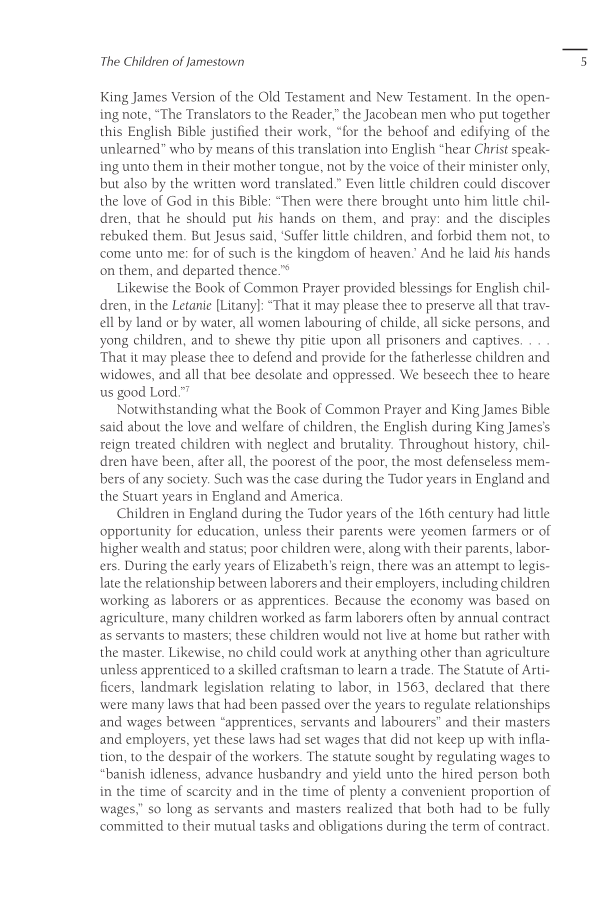The Children of Jamestown 5
King James Version of the Old Testament and New Testament. In the open-
ing note, “The Translators to the Reader,” the Jacobean men who put together
this English Bible justified their work, “for the behoof and edifying of the
unlearned” who by means of this translation into English “hear Christ speak-
ing unto them in their mother tongue, not by the voice of their minister only,
but also by the written word translated.” Even little children could discover
the love of God in this Bible: “Then were there brought unto him little chil-
dren, that he should put his hands on them, and pray: and the disciples
rebuked them. But Jesus said, ‘Suffer little children, and forbid them not, to
come unto me: for of such is the kingdom of heaven.’ And he laid his hands
on them, and departed thence.”6
Likewise the Book of Common Prayer provided blessings for English chil-
dren, in the Letanie [Litany]: “That it may please thee to preserve all that trav-
ell by land or by water, all women labouring of childe, all sicke persons, and
yong children, and to shewe thy pitie upon all prisoners and captives. . . .
That it may please thee to defend and provide for the fatherlesse children and
widowes, and all that bee desolate and oppressed. We beseech thee to heare
us good Lord.”7
Notwithstanding what the Book of Common Prayer and King James Bible
said about the love and welfare of children, the English during King James’s
reign treated children with neglect and brutality. Throughout history, chil-
dren have been, after all, the poorest of the poor, the most defenseless mem-
bers of any society. Such was the case during the Tudor years in England and
the Stuart years in England and America.
Children in England during the Tudor years of the 16th century had little
opportunity for education, unless their parents were yeomen farmers or of
higher wealth and status; poor children were, along with their parents, labor-
ers. During the early years of Elizabeth’s reign, there was an attempt to legis-
late the relationship between laborers and their employers, including children
working as laborers or as apprentices. Because the economy was based on
agriculture, many children worked as farm laborers often by annual contract
as servants to masters; these children would not live at home but rather with
the master. Likewise, no child could work at anything other than agriculture
unless apprenticed to a skilled craftsman to learn a trade. The Statute of Arti-
ficers, landmark legislation relating to labor, in 1563, declared that there
were many laws that had been passed over the years to regulate relationships
and wages between “apprentices, servants and labourers” and their masters
and employers, yet these laws had set wages that did not keep up with infla-
tion, to the despair of the workers. The statute sought by regulating wages to
“banish idleness, advance husbandry and yield unto the hired person both
in the time of scarcity and in the time of plenty a convenient proportion of
wages,” so long as servants and masters realized that both had to be fully
committed to their mutual tasks and obligations during the term of contract.
































































































































































































































